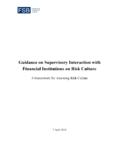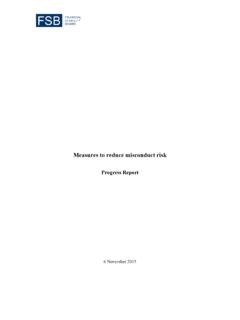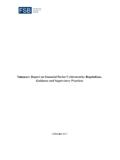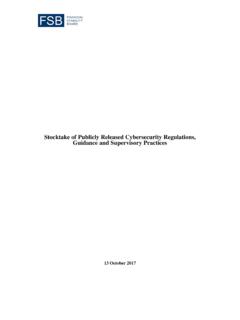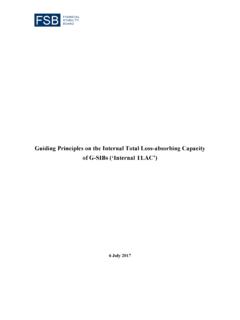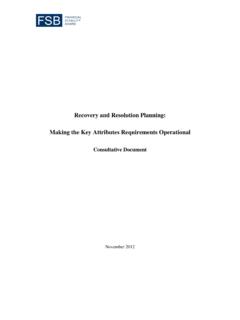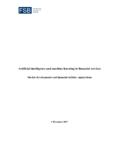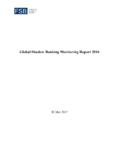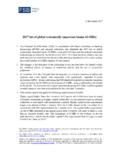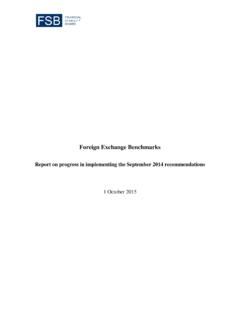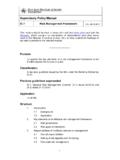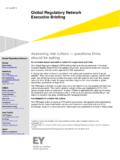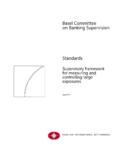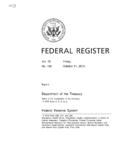Transcription of Principles for An Effective Risk Appetite Framework
1 Principles for An Effective Risk Appetite Framework 18 November 2013 i Table of Contents Page I. Introduction .. 1 II. Key definitions .. 2 III. Principles .. 3 1. Risk Appetite Framework .. 3 An Effective RAF .. 4 2. Risk Appetite statement .. 5 An Effective risk Appetite statement .. 5 3. Risk limits .. 6 Risk limits .. 6 4. Roles and responsibilities .. 7 The board of directors .. 8 The chief executive officer .. 9 The chief risk officer .. 10 The chief financial officer .. 10 Business line leaders and legal entity-level management .. 11 Internal audit (or other independent assessor) .. 12 1 I. Introduction Increasing the intensity and effectiveness of supervision is a key component of the financial stability board s (FSB s) Framework , endorsed by G20 Leaders, to reduce the moral hazard of systemically important financial institutions (SIFIs). As such, supervisory expectations for risk management particularly at SIFIs are increasing.
2 The October 2011 FSB progress report1 on enhanced supervision noted that Effective risk Appetite frameworks (RAFs) that are actionable and measurable by both financial institutions and supervisors have not yet been widely adopted. It concluded that the development of an Effective RAF is important for financial institutions and supervisors, and needs attention by both. The report recommended that supervisors discuss expectations for what a good risk Appetite Framework entails and how to supervise against these expectations. In light of these findings, the FSB launched a peer review on risk governance which was published in February Based on the findings of the review five recommendations were set out, one of which asked the FSB to develop, in collaboration with relevant standard setters, guidance on the key elements contained in an Effective RAF. The report also recommended the FSB to establish common definitions for terms used in RAFs to facilitate communication between supervisors and financial institutions, as well as within financial institutions (see Section II).
3 The FSB Principles set out key elements for: (i) an Effective risk Appetite Framework , (ii) an Effective risk Appetite statement, (iii) risk limits, and (iv) defining the roles and responsibilities of the board of directors and senior management (see Section III). The Principles aim to enhance the supervision of SIFIs but are also relevant for the supervision of financial institutions and groups more generally, including insurers, securities firms and other non-bank financial institutions. For non-SIFIs, supervisors and financial institutions may apply the Principles proportionately so that the RAF is appropriate to the nature, scope and complexity of the activities of the financial institution. An appropriate RAF should enable risk capacity, risk Appetite , risk limits, and risk profile to be considered for business lines and legal entities as relevant, and within the group context.
4 Subsidiaries of groups, in particular of SIFIs, should have a risk Appetite statement that is consistent with the institution-wide RAF and risk Appetite . The elements of the RAF should be applied at the business line and legal entity levels in a manner that is proportionate to the size of the exposures, complexity and materiality of the risks . Materiality should be determined by financial institutions, and discussed with supervisors, in accordance with their internal assessments of risk Appetite , risk capacity and risk profile, having regard to capital, liquidity and earnings at the entity level. The FSB Principles are high level to allow financial institutions to develop an Effective RAF that is institution-specific and reflects its business model and organisation, as well as to enable financial institutions to adapt to the changing economic and regulatory environment in order to manage new types of risk.
5 Establishing an Effective RAF helps to reinforce a strong risk culture at financial institutions, which in turn is critical to sound risk management. A sound risk culture will provide an environment that is conducive to ensuring that emerging risks that will have material impact on an 1 2 2 institution, and any risk-taking activities beyond the institution s risk Appetite , are recognised, escalated, and addressed in a timely manner. Supervisors should take steps to ensure financial institutions, in particular SIFIs, meet these Principles , and should regularly discuss with financial institutions any changes to its RAF, breaches in risk limits, significant deviations from the approved risk Appetite statement, as well as any material risks that the RAF does not adequately address. In the case of international groups, the RAF should be routinely discussed and assessed by supervisors, including at supervisory colleges.
6 II. Key definitions Definitions for key terms used in RAFs often differ across jurisdictions and even within financial institutions. The term risk Appetite Framework and its single elements may have different meanings throughout the industry. For the purposes of these Principles , the following definitions are used which aim to establish a common nomenclature for supervisors and financial institutions to facilitate discussions on risk Appetite . Risk Appetite Framework : The overall approach, including policies, processes, controls, and systems through which risk Appetite is established, communicated, and monitored. It includes a risk Appetite statement, risk limits, and an outline of the roles and responsibilities of those overseeing the implementation and monitoring of the RAF. The RAF should consider material risks to the financial institution, as well as to the institution s reputation vis- -vis policyholders, depositors, investors and customers.
7 The RAF aligns with the institution's strategy. Risk Appetite statement: The articulation in written form of the aggregate level and types of risk that a financial institution is willing to accept, or to avoid, in order to achieve its business objectives. It includes qualitative statements as well as quantitative measures expressed relative to earnings, capital, risk measures, liquidity and other relevant measures as appropriate. It should also address more difficult to quantify risks such as reputation and conduct risks as well as money laundering and unethical practices. Risk capacity: The maximum level of risk the financial institution can assume given its current level of resources before breaching constraints determined by regulatory capital and liquidity needs, the operational environment ( technical infrastructure, risk management capabilities, expertise) and obligations, also from a conduct perspective, to depositors, policyholders, shareholders, fixed income investors, as well as other customers and stakeholders.
8 3 Risk Appetite :3 The aggregate level and types of risk a financial institution is willing to assume within its risk capacity to achieve its strategic objectives and business plan. Risk limits: Quantitative measures based on forward looking assumptions that allocate the financial institution s aggregate risk Appetite statement ( measure of loss or negative events) to business lines, legal entities as relevant, specific risk categories, concentrations, and as appropriate, other levels. Risk profile: Point in time assessment of the financial institution s gross and, as appropriate, net risk exposures (after taking into account mitigants) aggregated within and across each relevant risk category based on forward looking assumptions. III. Principles 1. Risk Appetite Framework The development and establishment of an Effective RAF is an iterative and evolutionary process that requires ongoing dialogue throughout the financial institution to attain buy-in across the organisation.
9 The RAF sets the financial institution s risk profile and forms part of the process of development and implementation of the institution s strategy and determination of the risks undertaken in relation to the institution s risk capacity. For the purpose of these Principles , the RAF does not include the processes to establish the strategy, develop the business plan, and the models and systems to measure and aggregate The RAF should be aligned with the business plan, strategy development, capital planning and compensation schemes of the financial institution. An Effective RAF should provide a common Framework and comparable measures across the financial institution for senior management and the board to communicate, understand, and assess the types and level of risk that they are willing to accept. It explicitly defines the boundaries within which management is expected to operate when pursuing the institution s business strategy.
10 financial institutions that implement a RAF most effectively are those that incorporate the Framework into the decision-making process and into the institution-wide risk management Framework , and communicate and promote the Framework throughout the organisation, starting from the top. financial institutions and supervisors should check that the top down risk Appetite is consistent 3 The terms risk Appetite , risk tolerance , and risk limits can be used by authors with slightly different meanings; however, for clarity and simplicity, the FSB uses only the terms risk Appetite and risk limits. 4 Further guidance on these topics is available, for example, in the Basel Committee s Principles for Sound Liquidity Risk Management and Supervision (2008, available at ) or Principles for Effective Risk Data Aggregation and Risk Reporting (2013, available at ).
